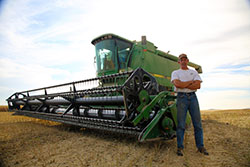|
Champions of Winter Canola and Spring Canola
Canola requires producers pay attention to the details.
The Magic of SRS resolves the viability of low
cost planting, high quality stands, with top yield projections.
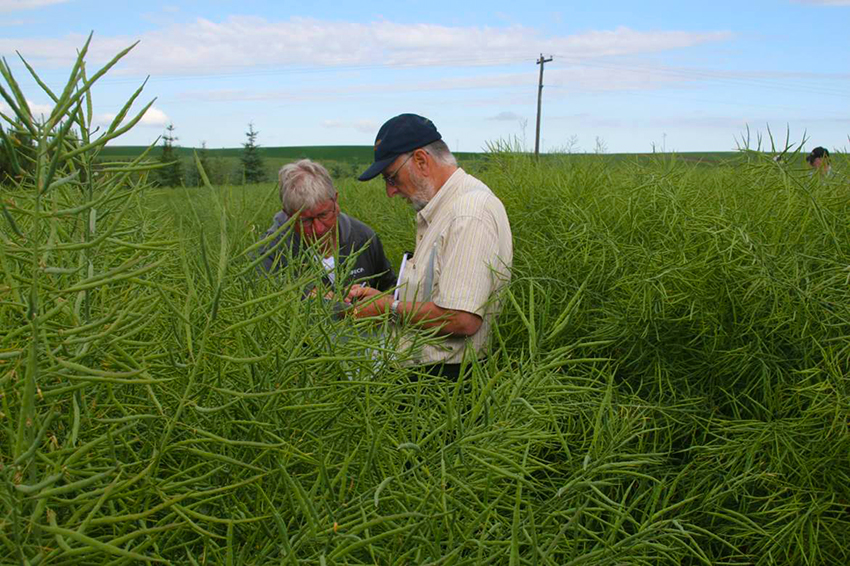
Two of the best, University of Idaho, The Leader in Oil Seeds,
Jack Brown, Brassica Breeder.
Jake Gross of Spokane Huetterian Brethren contract breeders for
Bayer hybrid Spring Canola, InVigro®
Inspection of Winter Canola plots at Craigmont Idaho. June 29, 17.

Deere 1710, 40 feet, 24 row, 20 inch planter modified with Exactrix®
SRS delivery in single or dual tube for flows to 65 gallons per
acre.
Dual Tube delivery is used for flows to 100 gallons per acre on 15
inch spacing.
Pump sizing is 65 gallons per minute for 60 to 90 foot planters.
Precision delivery of H2O plus MGPA and or KMag is assured with no
splashing of the planter components. .
The next chapter, SRS or Seed Row Saturation, assures Winter Canola
stands….in 4 to 5 days at 100 degrees F on windy days with even
seedling emergence.
· A chance to raise great crops in Kansas, Colorado, Nebraska,
Texas, Oklahoma and the PNW.
· Water flow rates are about 65 gallons per acre to 50 gallons per
acre on 20 inch spacing.
· Lower water flow rates are an exercise in wishful thinking.
· Mandatory for dryland and irrigated Winter Canola whether drilled
or planted.
· More news to come. Soybeans and Sunflowers march to war together
at 99% stands in 4 to 5 days.
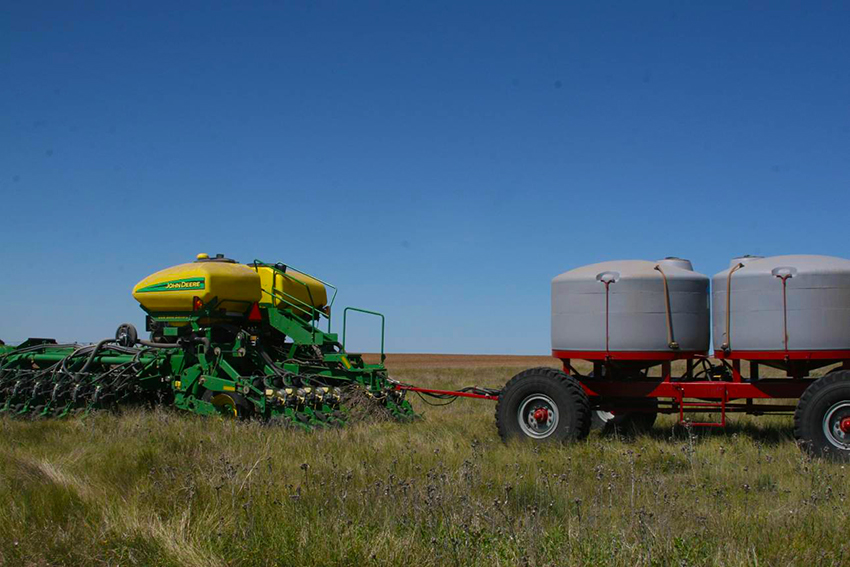
Hugoton, KS, June 19, 2017, Planting Sunflowers and Soybeans in
dryland and center pivots assures more even and uniform stands.
The Santa Fe Trail (1821-1881) is located directly under the Deere
40 foot, 20 inch row planter and water trailer.
Directly under the Santa Fe Trail tracks and the planter is the
largest Gas Field in North America, the Hugoton Gas Field.
Alongside the planter and the water supply trailer tanks is the
Cimarron National Grassland and now one of the driest true rivers in
North America
The Cimarron river dry stretch or the dry trail cutoff. . The “La
Jornada” of the Santa Fe.
Comanche Indians and water dominated the experience along the
Cimarron dry trail.
 |
The Butterfield Overland Dispatch. Russell Springs,
Sharon Springs. Cheyenne Wells.
In Kansas you are always fighting Indians and looking for
drinking water.
The plains Indians moved to Oklahoma and the water eventually
utilized to raise good crops with irrigation.
SRS now offers another benefit using water to create a good
crop stand. |
Keep your eye on the Grain Bins.
· This is Greg Sederstrom
· on the horizon is Goodland and the grain bins, South of Goodland
highway 27 to Sharon Springs which is on the Butterfield Trail.
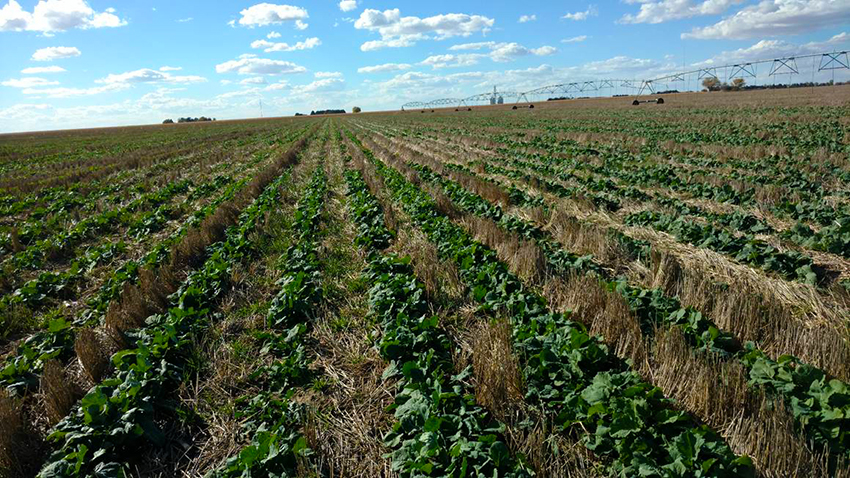
October 2, 2017, sprayed with a grass killer Select, not good, a
no no this late in the game.
Fall fertilizer did no good. The crop became very risky.
Fall fertilization of Winter Canola is dangerous unless it is side
dressed very late.
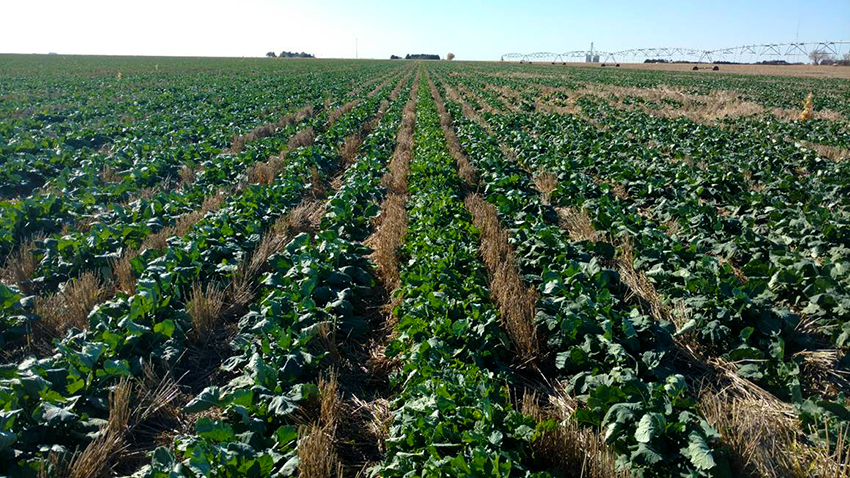
Greg Sederstrom, Nov. 2. 17 This crop is too big, this is too
much growth, 14 true leaves is about right, this crop had 42 leaves
and counting.
This crop should not have been fertilized in the pre-plant mode
The Hornet Winter Canola is too thick as the population is way too
high especially in one row….fall fertilized with the strip till bar.
TAPPS was applied pre-plant Strip Till at 50 lbs. N as NH3, 15 lbs.
P and 15 lbs. S and .5 lb. AZn……This should not be done….Naked Strip
Till is required.
One row is very heavy with a defective metering plate. Milo plates
were used which are too big. RRV (Red River Valley) Canola plates
are preferred for the Deere 1710.
Your planter is good to go at 60,000 to 80,000 population.
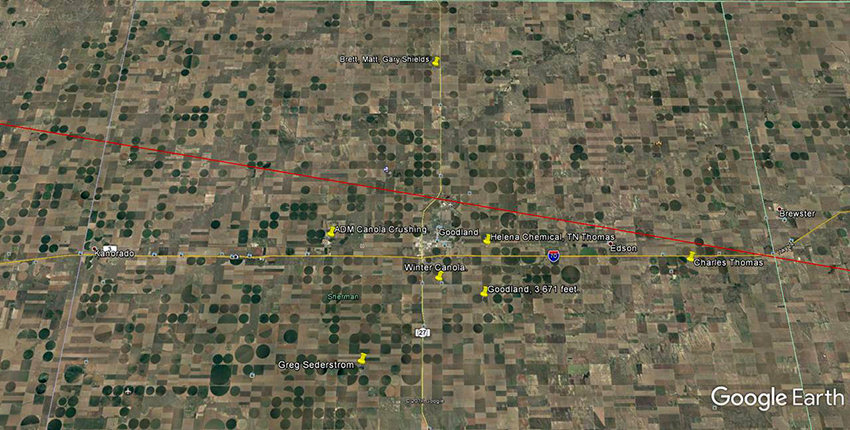
Some of the best farmland in Kansas is at Goodland. Deep soils
and a good moisture pattern can be expected.
Greg raises very good crops. The Winter Canola was established in
100 bushel per acre winter wheat residue.
The winter wheat made top yield and excellent protein with TAPPS
application with Mustang Openers in the spring.
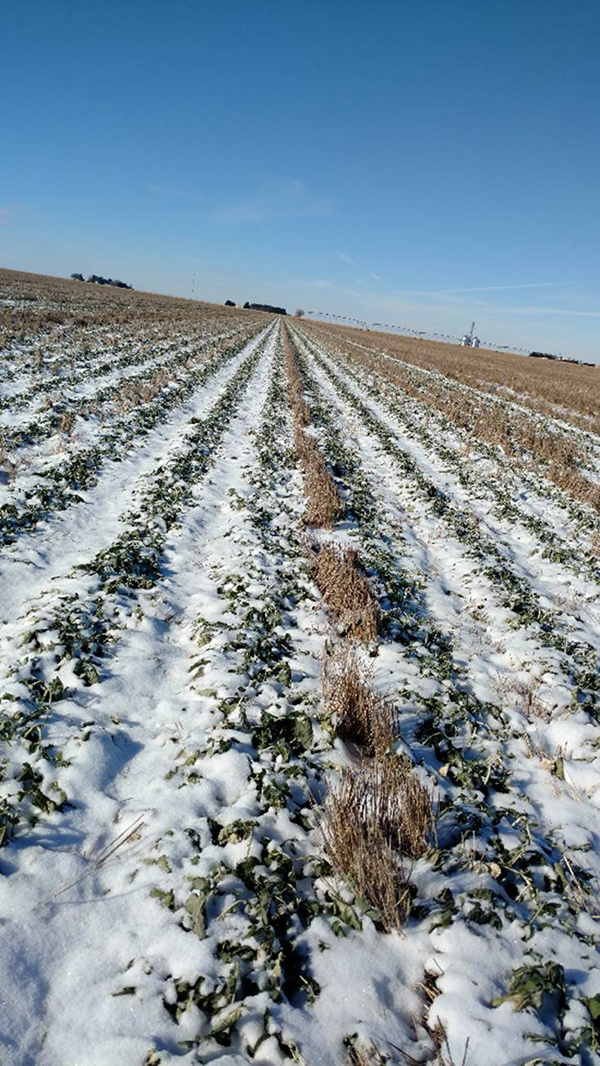
Following the Exactrix Colby Meeting on Dec. 7,
2016.
Dec. 8, 16 Snowfall overnight and then -15 degrees F. Great Plains
Weather was cooling down slowly crop was dormant.
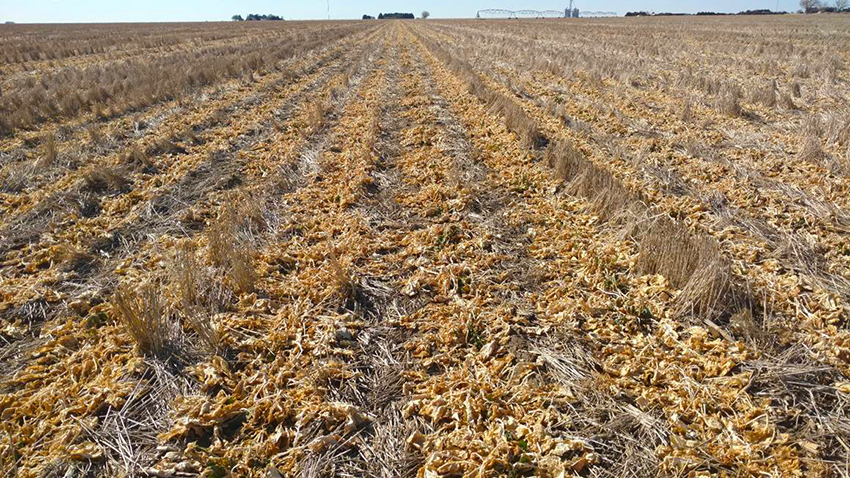
Late March, The Crop Is Pronounced Dead by
Swanson. It will never make a top yield. Corn is a better choice.
Guy Swanson told Greg to get ready with the corn planter,
survival was at about 2.
Rubisco, Brian Caldbeck said to “hang in there”. “The critical
hybrid, heavy duty crown design, looked good, The Crowns were OK.”
The crown generates the potential, this is
why it is so critical to not run machinery over the crown and to
consider late fall banding with Mustangs and side dress.
The crowns must be healthy in the spring as they grow through the
winter months. The Winter Canola bolt starts close to the Vernal
Equinox on the high plains.
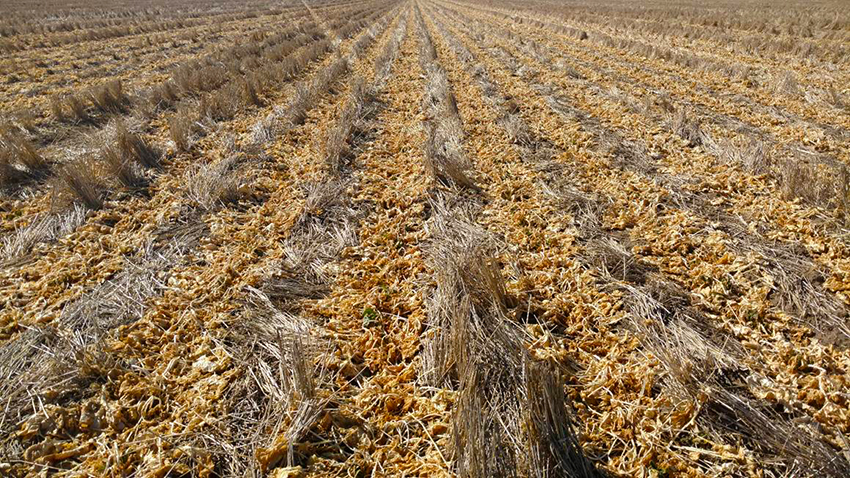
-
Side dressed with Mustangs, P-51C and TAPPS April 10,
2017.
-
Greg Sederstrom figured he could plant corn if it did not make.
-
The Rubisco, Hornet and Mercedes came alive after Mustang side
dressing Exactrix TAPPS at 50 lbs. N, 15 lbs. P and 15 lbs. S, ZN
and B.
- When Brian Caldbeck talks, you
listen up.
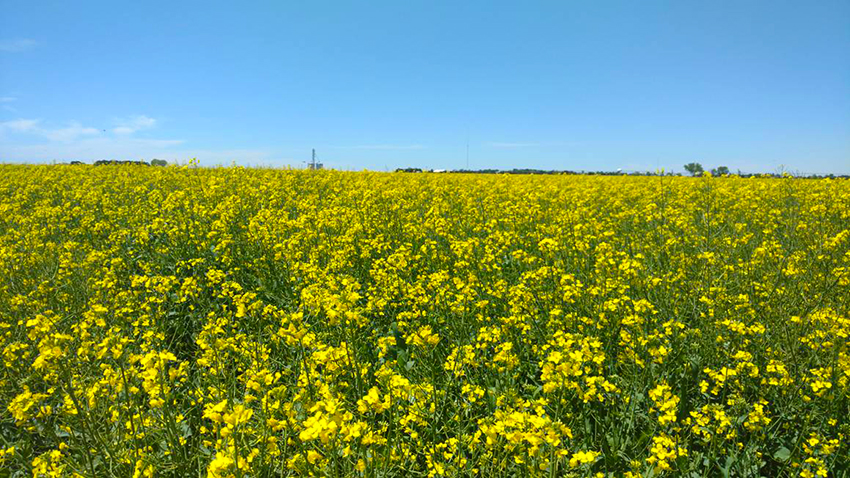
Goodland May 23, 17
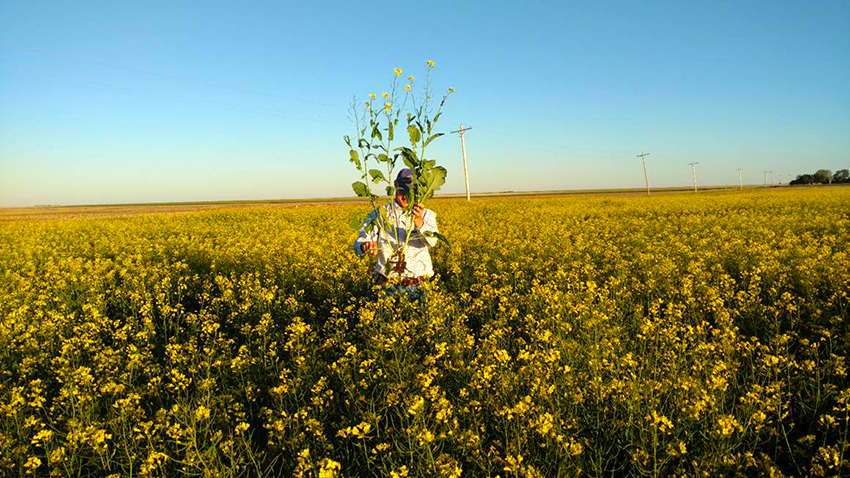
Mike Stamm, KSU, Winter Canola Plant Breeder on Tuesday eve at
Goodland May , 23. 2017 just before our Goodland Canola Training
meeting by ADM.
A cordial and expanding relationship exists between the breeders of
Open Pollinated KSU and OSU varieties and Rubisco Hybrids from
Europe.
DeKalb and Pioneer seem to have a passing interest.
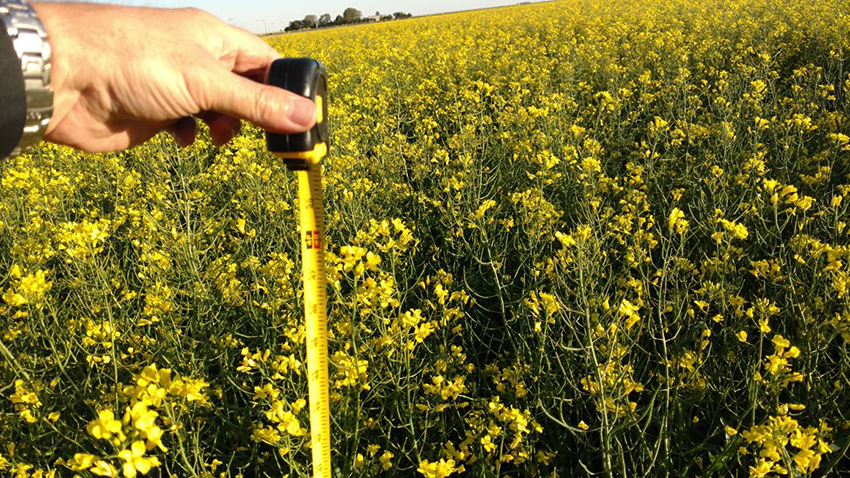
Goodland, the Bins are still in sight
barley as the Winter Canola reaches full elongation,
May 26, 17
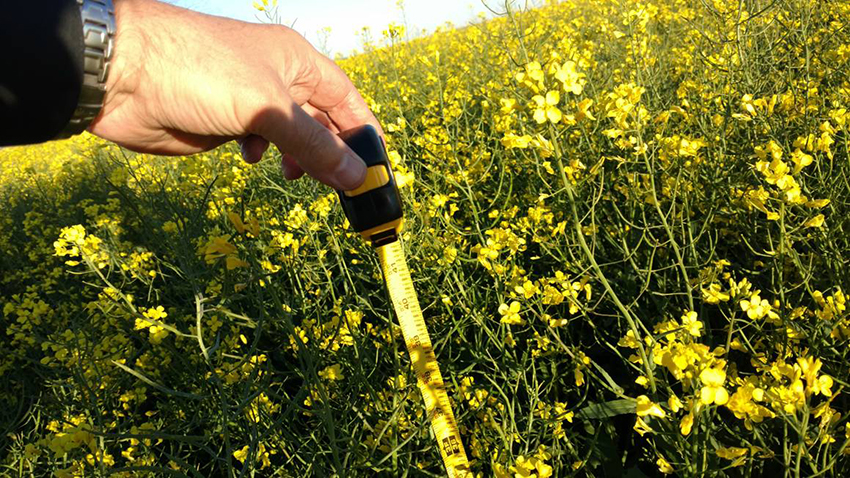
May 26, 17 going to full bloom at Goodland.
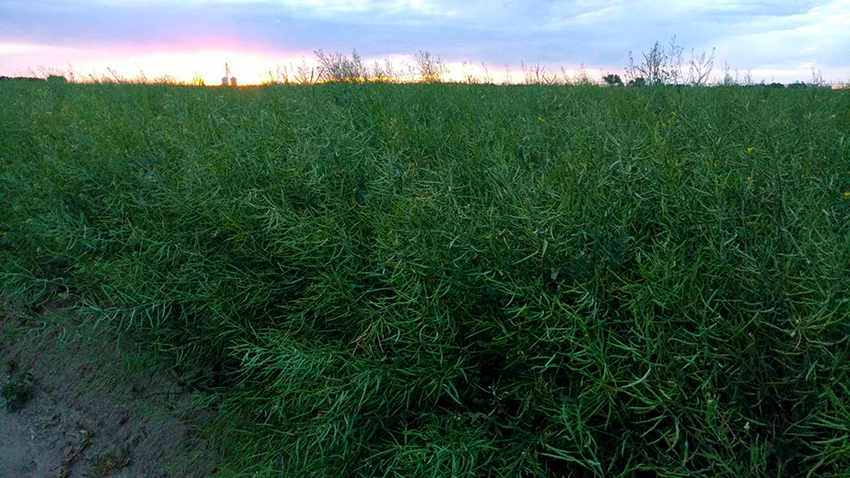
June 17, 17, Sunset at Goodland, and
the Grain Bins are blocking an extreme northwestern sunset.
The WC still has a few blooms and filling nicely….Greg will add
about 2 more inches of water to get a complete fill to the top.
At
least 7 - 7.5 weeks of bloom.
Goodland, Canola production, looks pretty
good. Rubisco, Mercedes and Hornet Varieties selected. The banker
said it could not be done.
This is a bankable crop, .considering Greg
tried to kill it about 5 times. Now this is what is great about
Goodland, KS.
“Everything seems to work. Magnetic Goodland and Magic Sederstrom.”
GJS.

Crowns get big with a planter. Winter Survival and high yield
potential with reduced costs.
Rubisco, Hornet, Planter is Deere 1710 on 20 inch about 80,000 pop,
grew through the winter…picture is March 3, Hugoton, Joe McClure.
Late Winter/Spring Storm Ursa is on the way in about 58 days, about
April 28 to May 1. Snowfall was 15 inches with 60 mph winds at 30 to
32 degrees F. The cattle herd was reduced by 20,000. The death and
destruction in the adjoining Grant County occurred by May 1,
17. Some areas close by received 22 inches of snowfall on growing
winter crops moving to maturity. .
The crowns are the secret to survival and a good crop, they store
the energy and reset the plant.
The crowns work and economically grow best at 4 to 5 inch spacing.
Row cleaners required, SRS is now required, TAPPS Mustang Required.
Hybridization helps the plant to regenerate and come back after
grazing.
Do not run over the crowns with the tractor or sprayer if you can
avoid it, side dressing TAPPS with Boron and Zinc, Copper on 30 inch
is critical to top yields. On sandy soils with high pH and low CEC
requires Manganese the Boron.
TAPPKTS with a complete micro nutrient metals package is also a good
choice on sandy soil. Don’t short the micro nutrients and they
should always be banded and not foliar applied.

Feb 28, 2017, From the soil pit. Fibrous roots go deep and
wide…overall width is 48 inches and depth to 8 feet. 20 inch rows to
30 inch rows work well.
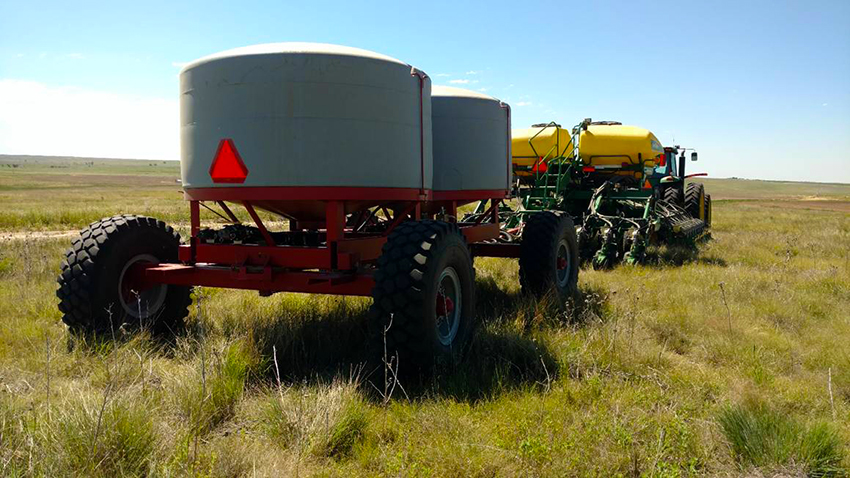
SRS is the next chapter. SRS, Seed Row Saturation, beats your
expectations every time. Proven in the 80’s with Yielder Drills in
steep Palouse slopes.
Seed Row Saturation allows expensive seed to be more
efficient. Assures a stand every time. Allows future undiscovered
crops to be planted with good results.
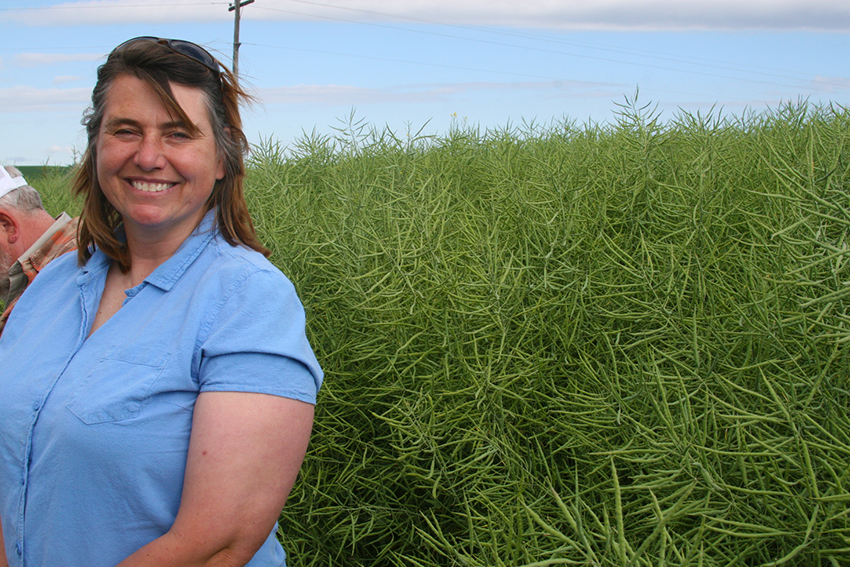
June 29, 17, This is Cadie Pruss. DC for Lewis and Clearwater
Counties. District Conservationist Cadie Pruss
This is the administrator for the Clearwater Conservation District
checking out the PNW, U of I plots at Craigmont, Idaho.
She is 5 foot 10 inches in height with the Mercedes Canola going
over her head.
She is an advocate of No-tillage, nutrient management and clean
water for the seagoing fish of the Clearwater River and Salmon
River. One of her jobs is to help the Steelhead (Sea Going Trout)
and Sockeye Salmon find their breeding grounds in Bitterroot range
of Idaho and the Sawtooth Range at Redfish Lake
Jack Brown’s staff provides valuable information on Canola. A
valuable conservation tool.
Water infiltration into the soil is 3 times faster with measurements
made following Spring Canola on Winter Wheat as compared to Spring
Wheat on Winter Wheat.
In fact Winter Canola is even better news than Spring Canola….at 4
times faster water infiltration. Thus the solution is simple…better
yields become even better understood. Is it fumigation? Is it
nitrate harvesting? Is it nematode habitat suppression? The power of
this winter crop rotation is well known.
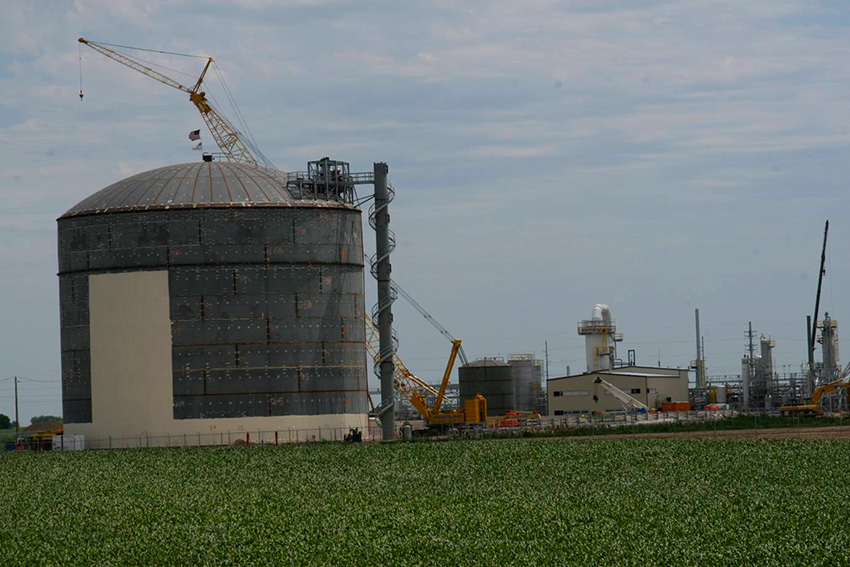
Youngest NH3 plant in the USA and the most advanced, Fortigen,
Geneva, NE. June Ready, Set, Go for the next 100 years….Starts in
July.
Small NH3 plants are regionalized (100 mile R) to overcome
transportation and market manipulation using transportation to drive
NH3 shortages and much higher prices.
Market assurance is provided by a large Coop with financial punch to
own 50% of the deal. Mid-America pipelines provides the natural gas.
Adequate NH3 storage on farm makes more sense every time you look at
the game of NH3 pricing. World Market pricing is expected to hit
$140 per ton in late fall 2017.
Transportation and locked down, inland markets drive the NH3 price
higher.
From Zimbabwe and the Kalahari desert,
An African production method from the 3rd world.
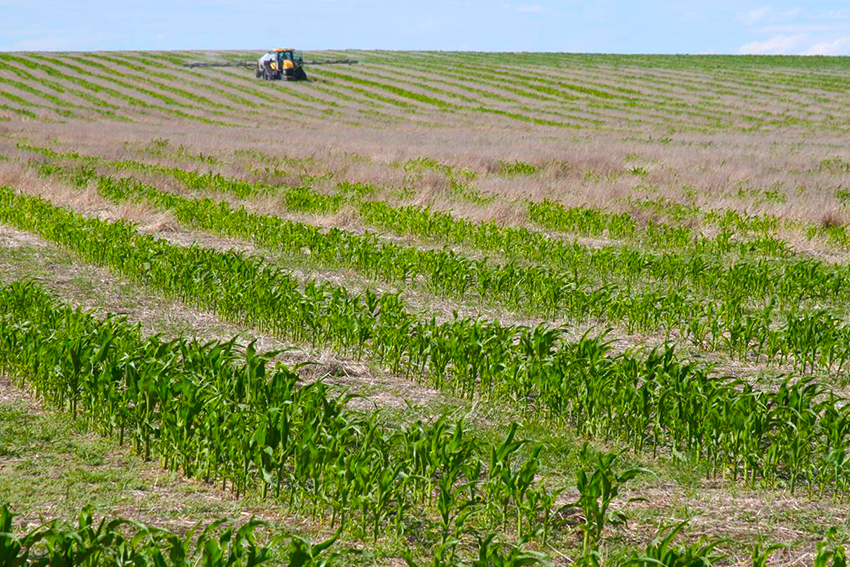
Check out the plant in row population, not the per acre rate, but
the in row population.
Developed for top dressed Urea and the extreme seed corn
population. Application date is June 23,17 with expensive treated
Urea with an assured tie up in the residue.
With this design seminal roots go deep fast with pressure from
adjoining corn plant seminal roots.
Hill planting producers a similar rooting effect.
The goal is store unused, soil stored moisture, for later access by
exploratory branching fibrous roots…and to open the canopy to light
with the off row light effect.
This is a Great Plains scenario…and highly questionable compared to
current corn VRT, site specific and placement of TAPPS with 1%
uniformity of application.
Mustang openers allow banding to 8 inch depths directly under the
row using Thio-Sul® to stabilize the TAPPS bands. Phosphate goes to
work fast.
The Skip row technique is not compatible with Rotational Band
Loading for future crops. Most likely not insurable in your area.
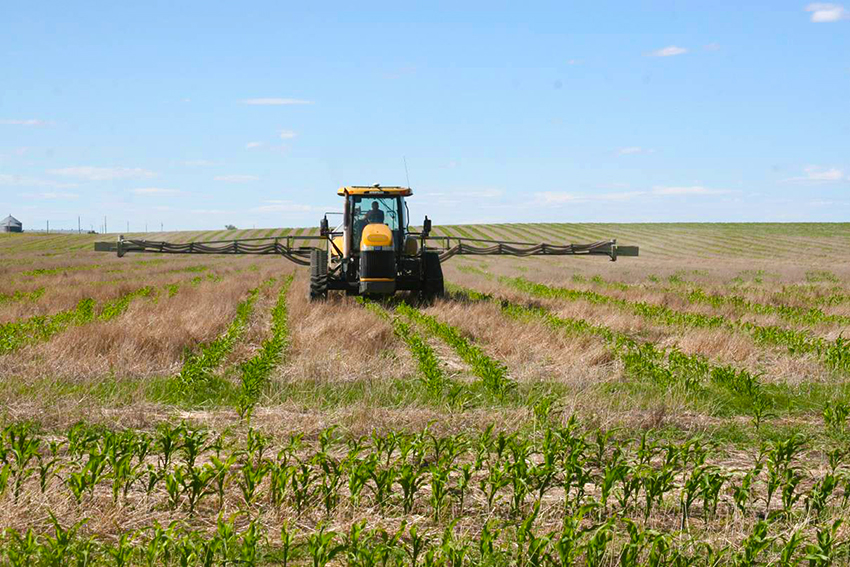
The Third World designs allows this Great Plains producer to
minimize the investment in machinery and operate with a salvage
technique.
A 60 foot planter has 12 openers in skip 2 and plant 2,
and the metered plant population is about 2 to 2.5 times
greater than it should be.
The Urea is top dressed above the rows. Seed row phosphate is
applied in dry form with the same applicator towed behind the
planter.
This is a very difficult method to make zinc and micronutrients work
economically.
Planning for failure and Non Insurable. Low risk, and backwards
technology but not too bad in failure mode.
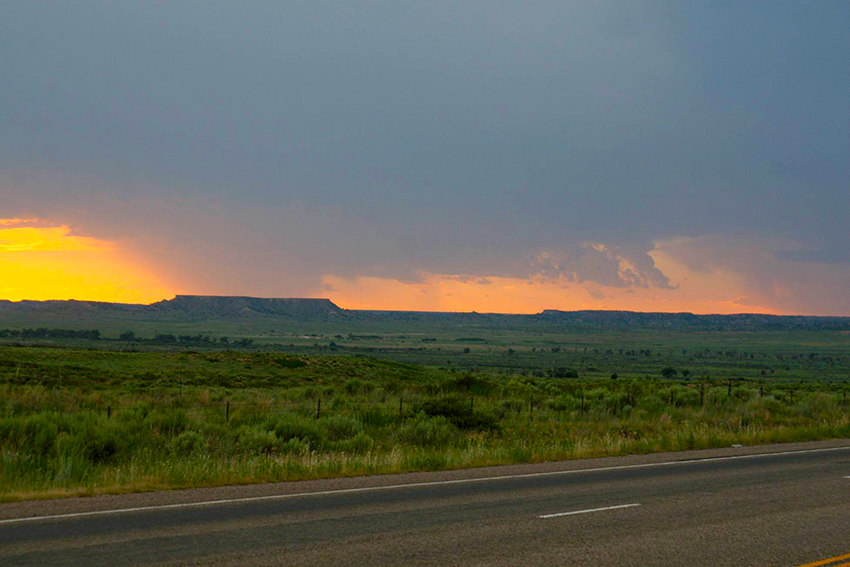
Sunset on the Canadian River Valley, North of Pampa, Texas.
A small part at the eastern edge of the very large Hugoton Gas Field
and good farming area at Perryton, Texas.
Your Great Plains Reporter.

Guy J Swanson
|


























